WELCOME TO BRUM BEAT!
THE MOODY BLUES, THE ROCKIN' BERRIES, THE APPLEJACKS, THE FORTUNES, THE SPENCER DAVIS GROUP, THE MOVE, ROY WOOD, TRAFFIC, BLACK SABBATH, SLADE, ELO & WIZZARD, JUDAS PRIEST, STEVE WINWOOD, ROBERT PLANT, JEFF LYNNE, CHRISTINE McVIE, OZZY OSBOURNE, TONY IOMMI, JOHN BONHAM and many more!

dedicated to all the groups and people who were part of the West Midlands music scene in the 1960s
This group picture was taken at Selly Oak, Birmingham in 1960. The line-up are from left to right; Mal Edwards, Bob Nash, unknown, Roger Blakemore, Barry Woodhouse and Francois "Franzy" Wagstaff. Mal Edwards later became a member of "The Rockin' Jaymen" who were signed to Columbia Records in 1963 and became Pat Wayne and The Beachcombers.
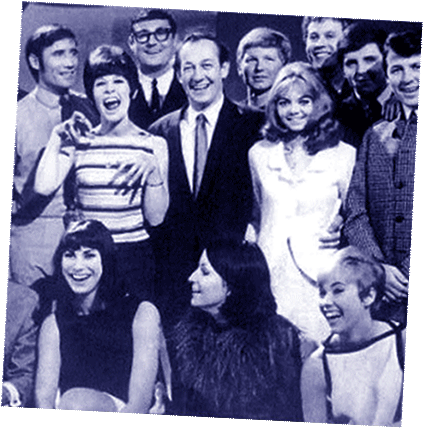
Why the 1960s?
There has never been a decade, before or since, that has produced so much innovation and creativity regarding the development of popular music. This was particularly true in Britain where the "Mersey Sound" led by The Beatles and others, would ensure that British popular music would have a far-reaching influence on the rest of the world.
The 1950s may have "lit the fuse" in terms of rock 'n' roll, but the 1960s was the explosion. Considering this, the period may be described as "The Big Bang" because of the long and continuing influence the 1960s had on the development of popular music in the following decades.
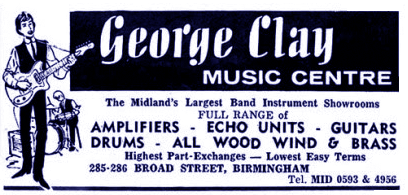
The term "Brum Beat" or "Brumbeat" originated in the early 1960s in the wake of the famous "Mersey Sound" (later incorrectly described as "Mersey Beat") that came out of Liverpool and was spearheaded by such well known groups as The Beatles, Gerry and the Pacemakers, and The Searchers. (Mersey Beat was actually the name of the famous Liverpool music scene and entertainment newspaper founded by Bill Harry - see www.mersey-beat.com)
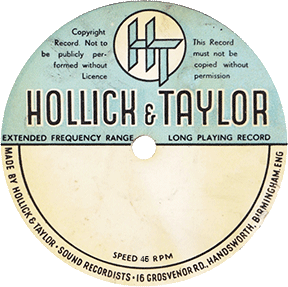
The Mersey Sound was sweeping all over the country by early 1963, resulting in the big record companies (based in London) looking to northern cities in search of similar marketable talent. Cliff Richard and The Shadows producer Norrie Paramor of EMI Records, went up to "Brum" (slang for the City of Birmingham) to audition the local bands and performers with the aim of signing the best of these to recording contracts.
Birmingham is a large industrial city located geographically in the "West Midlands" about halfway between London and Liverpool. It was thus subjected to influence from the Liverpool sound in the north made popular by The Beatles, and also the emerging rhythm and blues in the London area promoted by bands like the Rolling Stones.
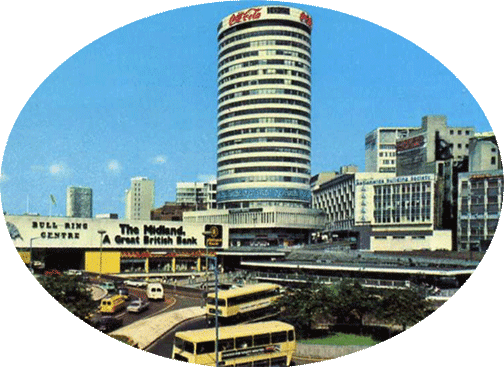
The West Midlands not only included Birmingham, but also the heavily populated area to the north west as far as Wolverhampton and known locally as the "Black Country" because of its long history of coal mining, steel making, and heavy industrial activity. This area includes towns such as West Bromwich, Walsall, Dudley, and Stourbridge.
The groups from Birmingham that were signed up in 1963 by Norrie Paramor for issue on the "Columbia" record label were; Carl Barron and The Cheetahs, Mike Sheridan and The Nightriders, Pat Wayne and The Beachcombers, Keith Powell and The Valets, and Danny King and The Royals.
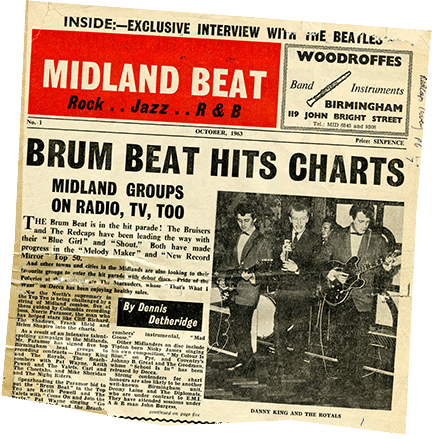
Norrie Paramor apparently came up with the term "Brum Beat" as part of an advertising campaign to promote national interest in the bands he had signed from Birmingham, but Brumbeat would become known more for the geographical location that certain groups and performers came from, rather than for a single unifying "sound".
The following year, Decca Records also auditioned Birmingham groups and the bands they signed up included; The Redcaps, Gerry Levene and The Avengers, The Brumbeats, Carl Wayne and The Vikings, The Rockin' Berries, and The Applejacks. This latter group became the first local band to break into the British Top Ten national record chart following the release of their hit single titled 'Tell Me When'.
It wasn't until later in 1964 that Birmingham could claim a truly international hit group when the Moody Blues entered the record charts with 'Go Now' that got to Number One in the UK and made Top Ten in America, thus opening the flood gates for other local bands.
The purpose of this web site
The major goal of the BrumBeat web site is to gain recognition for as many as possible of the West Midlands groups and individuals from the 1960s who helped create a local music scene that allowed so much individual and collective musical talent to flourish.
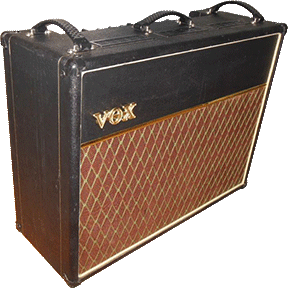
The West Midlands music scene during the 1960s was very different from today. Before discos took over in the 1970s, live music ruled. There were so many venues (pubs, clubs, dance halls) where bands could play so bookings (gigs) were plentiful. Very few venues where bands played in the 1960s still exist today.
These days, a good band might have difficulty finding one gig a week but in the 1960s, groups could play almost every night if they wanted to. In fact it was commonplace for a group to play two or even three gigs - each at a different venue - all on the same night!
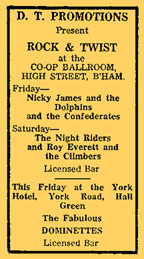
Today, most people are less likely to go out for a drink, dance, socialize and be entertained. It's easier, safer (and cheaper) to watch big-screen TV at home and have beer in the fridge. Sixty years ago, few kept much alcohol in the house except at Christmas time.
The West Midlands did have its own thriving music scene prior to the Mersey Sound, but few of the local performers were well known outside of the Birmingham area. Until fairly recently, most of the local bands of that time were ignored or forgotten unless they were in some way connected to a famous group.
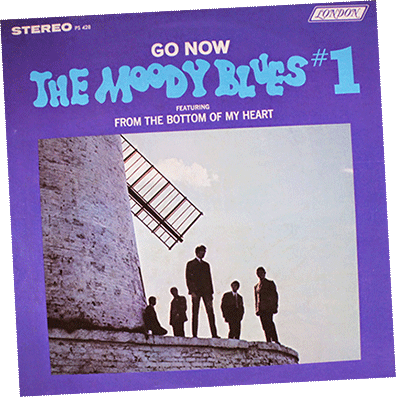
Many of the more well-known bands and performers on this site have both official and un-official web sites devoted to them. Examples are The Moody Blues, The Spencer Davis Group, The Move, Traffic, Slade and Black Sabbath.
Some of the bands listed in the MAIN INDEX (such as the ones mentioned above) are well known to most music fans and much information can be found about them, but for many of the others, little was known although they were still very much a part of the scene from which a lot of famous names have emerged.
With this in mind, I encourage anyone who was a part of the West Midlands music scene in the 1960s or even an observer or interested researcher like myself, to e-mail me at: john@brumbeat.net if you have stories or information you would like to share in order to help set the record straight.
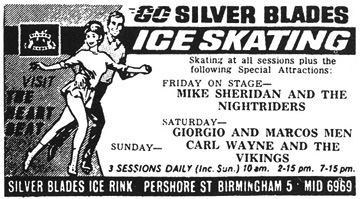
NOTE: Please don't contact me if you're looking for old friends or band mates. That's what facebook is for and if they aren't on it they probably don't want to be contacted. Privacy is a concern. I won't give out contact information unless there's a very good reason.
www.brumbeat.net should be regarded as a "work in progress" and will be updated periodically.
The photos shown on this site...
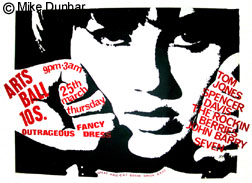
Effort has been made to identify the copyright holders of photos shown on this website. If you own the copyright to a photo displayed and do not want the photo to be shown, you can e-mail me at john@brumbeat.net with proof of ownership and I will remove the photo as requested.
Many thanks to Mike Lavender and Laurie Hornsby at TGM Ltd. for allowing some of the images that appear in the book Brum Rocked! to be used on this site. Thanks also to all those who have submitted previously unpublished photos from their private collections.
I would like to recognize those whose consistent support and contribution to the BrumBeat web site over many years have helped make it what it is today. They are; Graham Ashford, Mick Adkins, Bill Bonham, Pete Bryan, Bulls Head Bob, Brian Nicholls, Rob Caiger, Keith Farley, Will Hammond, Mike Lavender, Laurie Hornsby, Johnny Neal, John Olczak, John H. Warburg, Nick Warburton, Barry Woodhouse, and last but not least, my amazing wife Melanie whose patience and understanding has made this possible!